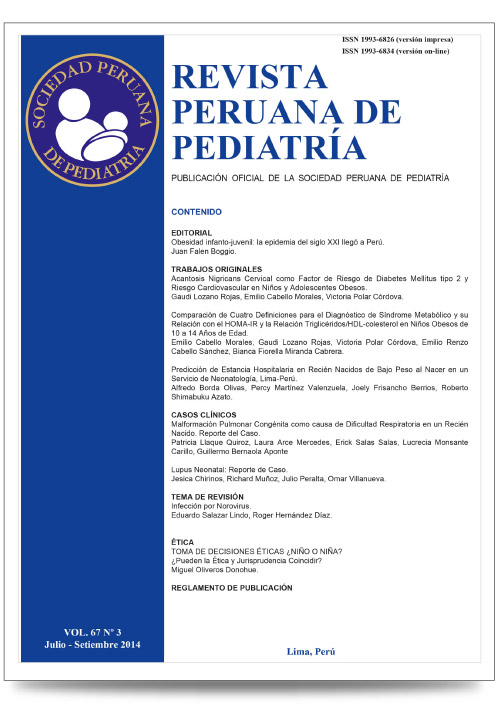Prediction of Length of Hospital Stay in Low Birth Weight Neonates in a Department of Neonatology, Lima-Peru
Trabajo Ganador del Tercer Lugar en el XXVIII Congreso Peruano de Pediatría. Ica, Perú.
DOI:
https://doi.org/10.61651/rped.2014v67n3p148-157Keywords:
Length of Stay, Infant, Low Birth Weight, Infant, Newborn, PeruAbstract
Objectives: To establish a predictive model of hospital stay of low birth weight neonates at the time of admission to the Neonatal Service.
Materials and methods: This is an observational, retrospective study of newborns admitted to Neonatal Service from January 1999 to March 2008. The dependent variables were: a) hospital stay, b) prolonged hospital stay, defined as greater than 14 day stay. The independent variables were intrinsic factors of newborns. Univariate analysis and multivariate analysis was performed by multiple linear regression to establish a predictive model of hospitalization. The extended stay was analyzed using binary logistic regression.
Results: Low birth weight, infectious problems and malformations explained 18.21% of the variability of hospital stay (adjusted R2 0.18) being the contribution of birth weight greater than the problem of infection and malformations (semipartial R2: 9.7%, 6.2%, and 1.9% respectively). Factors associated with prolonged hospital stay were also low birth weight, infectious problems and malformations [OR 10.6 (95% CI 3 to 37.2); OR 2.8 (95% CI 1.5 to 5.1) and OR 3.1 (95% CI 1.7 to 5.7), respectively]. This model is well calibrated (HL 0.37) and adequate discrimination (AUC: 74.5; 95% CI: 68-81).
Conclusions: The prediction of hospital stay found in this study is low, being better prediction of prolonged stay. This study provides information that may be useful in developing strategies associated with longer stay.
Downloads
Downloads
Published
How to Cite
License

This work is licensed under a Creative Commons Attribution 4.0 International License.
Authors will retain the copyright and grant the right to publish their work in the journal while allowing third parties to share it under the Creative Commons Attribution license.
Articles are published under a Creative Commons license that allows sharing and adaptation with appropriate credit. CC BY 4.0 license. Available in English at https://creativecommons.org/licenses/by/4.0/
Authors may use other information disclosure formats as long as the initial publication in the journal is cited. The dissemination of the work through the Internet is recommended to increase citations and promote academic exchanges.
The published content does not necessarily reflect the specific point of view of the journal, and the authors assume full responsibility for the content of their article.




